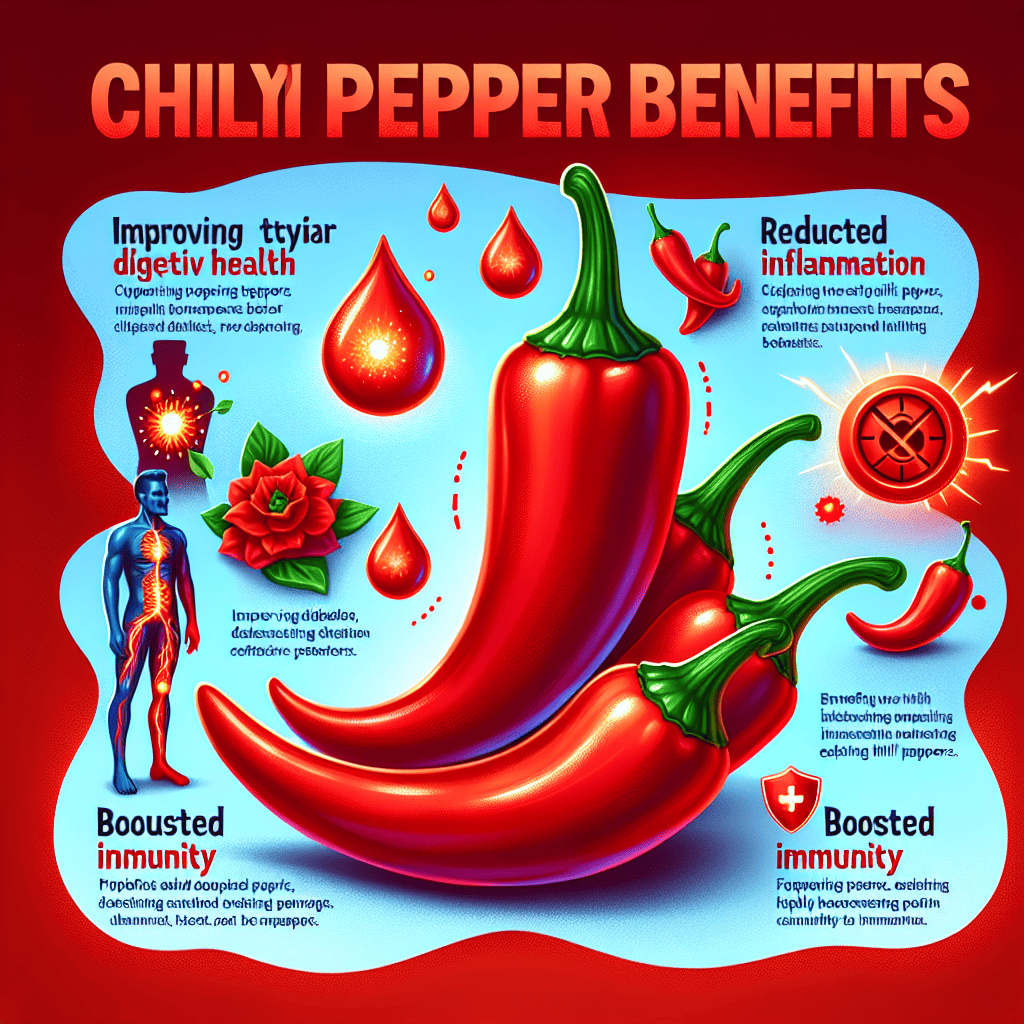Introduction: Chili peppers are not only known for their spicy flavor but also for the various health benefits and potential side effects associated with their consumption. This guide delves into the intricacies of chili peppers, including their positive impacts on health, potential harms, nutritional value, and answers to common questions.
Table of Contents
Benefits of Chili Pepper
Discover the numerous benefits that chili peppers offer for overall health and wellness.
- Improving conditions for diabetics:
Chili peppers have been found to have significant benefits for individuals with diabetes. Research suggests that chili peppers can enhance insulin production in the body, which is crucial for regulating blood sugar levels. This natural stimulant can be particularly helpful for people with diabetes, as it can potentially aid in managing their condition effectively. By incorporating chili peppers into their diet, diabetics may experience a reduction in blood sugar levels and improve their overall health.
Studies have indicated that the compound responsible for the heat in chili peppers, known as capsaicin, may play a key role in the beneficial effects on diabetes. Capsaicin has been linked to increased insulin sensitivity, which can lead to better control of blood sugar levels. Furthermore, chili peppers have anti-inflammatory properties that could also contribute to improved insulin function and glucose metabolism. These findings have sparked interest in the potential therapeutic applications of chili peppers and capsaicin in managing diabetes and may offer a natural approach to supporting conventional treatments.
In addition to the impact on insulin production and blood sugar regulation, chili peppers can also provide other health benefits for individuals with diabetes. These include antioxidant properties, which can help reduce oxidative stress and inflammation in the body. Reducing these factors is important for preventing complications associated with diabetes, such as cardiovascular disease and nerve damage. By incorporating chili peppers into their diet, diabetics may not only experience better blood sugar control but also improve their overall well-being and reduce their risk of developing related health issues.
- Reducing joint pain:
Capsaicin, the active compound found in chili peppers, has been found to possess remarkable properties that can help alleviate joint pain. It is considered to have analgesic effects, making it effective in reducing pain and discomfort associated with conditions such as arthritis. Capsaicin works by interacting with pain receptors in the body, resulting in a decrease in pain perception. This mechanism of action makes it a potential natural remedy for individuals looking for alternative ways to manage joint pain.
Various studies have provided evidence supporting the efficacy of capsaicin in reducing joint pain. Regular consumption of chili peppers, which contain capsaicin, has shown promising results in improving symptoms related to joint inflammation. Furthermore, capsaicin has been used in topical creams and ointments for localized pain relief, offering a non-invasive option for individuals experiencing joint pain. The ability of capsaicin to block pain signals and reduce inflammation makes it a valuable component in pain management strategies for those with arthritis and other joint-related conditions.
In addition to its pain-relieving properties, capsaicin also has other potential health benefits. It may help improve circulation, promote healthy digestion, and boost metabolism. The compound is known for its anti-inflammatory and antioxidant properties, which can contribute to overall wellness. However, it is essential to consult with a healthcare provider before incorporating capsaicin into your routine, especially if you have existing health conditions or are taking medications that may interact with this compound. Overall, the research on capsaicin and its role in alleviating joint pain continues to show promise, offering a natural and potentially effective option for managing discomfort and improving quality of life for individuals with joint issues.
The Harm of Chili Pepper
Explore the potential side effects and precautions associated with consuming chili peppers.
- The safety of using chili pepper:
Chili peppers are a staple ingredient in many cuisines around the world due to their spicy heat and flavor. They contain a compound called capsaicin, which is responsible for the burning sensation when consumed. Although chili peppers are generally safe to eat in moderation, consuming them in high doses can lead to stomach upset and irritation. This is because capsaicin can irritate the lining of the stomach, leading to discomfort and potentially more severe issues. Therefore, it is crucial to be cautious when consuming chili peppers, especially in large quantities.
In addition to causing stomach upset, consuming high doses of chili peppers can also lead to other gastrointestinal issues such as heartburn, indigestion, and even exacerbate conditions like gastritis or ulcers. The severity of the symptoms can vary depending on individual tolerance levels and the amount of chili peppers consumed. It is essential for individuals with sensitive stomachs or pre-existing gastrointestinal conditions to be particularly careful when consuming chili peppers. To mitigate the risk of stomach irritation, it may be advisable to start with small amounts of chili peppers and gradually increase the quantity to gauge tolerance levels.
Furthermore, while some people enjoy the fiery sensation brought by eating chili peppers, it is important to be mindful of one’s own limits and listen to the body’s signals. If discomfort or irritation occurs after consuming chili peppers, it is recommended to stop consumption and allow the stomach to settle. Drinking milk or eating yogurt, which contain casein proteins that help neutralize the capsaicin, can also provide relief. Overall, while chili peppers can add a delicious kick to dishes, it is crucial to consume them in moderation and be aware of the potential effects of high doses on stomach health.
- The precautions of using chili pepper:
When considering precautions for different age groups, it is important to understand that children and older adults may be more susceptible to certain medications or treatments due to differences in metabolism or potential underlying health conditions. For children, dosages may need to be adjusted based on their weight or age to ensure safety and efficacy. On the other hand, elderly individuals may have decreased organ function, which can affect how their bodies process medications. It is crucial for healthcare providers to take these factors into account when prescribing treatments to these age groups to minimize the risk of adverse reactions.
Pregnant or breastfeeding women require special considerations when it comes to taking medications or undergoing certain treatments. Some medications may cross the placenta and affect the developing fetus, while others can be transferred to the infant through breast milk. Healthcare professionals need to carefully weigh the benefits of treatment against the potential risks to the mother and baby. In some cases, alternative medications or treatment options that pose less risk may be recommended. It is important for pregnant or breastfeeding women to always consult with their healthcare provider before taking any new medications or undergoing procedures.
Individuals with specific health conditions, such as heart disease, diabetes, or kidney problems, may need tailored precautions to ensure their safety during treatments. Certain medications or procedures may interact with existing health conditions or medications, leading to complications. Healthcare providers need to thoroughly assess a patient’s medical history and current health status to determine the most appropriate course of action. In some cases, modifications to dosages, treatment plans, or even alternative therapies may be necessary to prevent adverse effects. Patients with chronic health conditions should work closely with their healthcare team to develop a comprehensive care plan that takes into account their individual needs and risks.
The Nutritional Value of Chili Pepper
Learn about the nutritional content of chili peppers and their contribution to a healthy diet.
- Nutrient-rich profile:
Chili peppers are not only known for their spicy kick but also for being rich in essential nutrients. One key nutrient found in chili peppers is vitamin C, which is essential for a healthy immune system, skin health, and wound healing. Consuming chili peppers can contribute to meeting the daily recommended intake of vitamin C, helping the body fight off infections and illnesses.
Another important nutrient present in chili peppers is vitamin B6, also known as pyridoxine. Vitamin B6 plays a crucial role in various bodily functions, including metabolism, cognitive development, and the production of neurotransmitters. Incorporating chili peppers into the diet can help ensure an adequate intake of vitamin B6, which is necessary for overall health and well-being.
In addition to vitamins, chili peppers are a good source of minerals like potassium and magnesium. Potassium is essential for maintaining proper nerve function, muscle contraction, and fluid balance in the body. Magnesium, on the other hand, is involved in more than 300 biochemical reactions in the body, supporting processes such as energy production, protein synthesis, and muscle function. By including chili peppers in meals, individuals can boost their intake of these important minerals and support their overall health.
- Caloric content and macronutrients:
Chili peppers are low in calories but pack a flavorful punch. A single raw chili pepper (approximately 45 grams) contains about 18 calories. Despite their low caloric content, chili peppers are a good source of various essential nutrients. They are particularly rich in vitamin C, providing about 108% of the recommended daily intake in just one serving. These peppers also contain small amounts of other vitamins and minerals like vitamin A, vitamin K, potassium, and magnesium.
When it comes to macronutrients, chili peppers are primarily made up of carbohydrates. In a 45-gram serving, a chili pepper contains around 4 grams of carbohydrates, which includes sugars and dietary fiber. Fiber is an essential component of a balanced diet as it promotes healthy digestion, aids in weight management, and helps control blood sugar levels. Chili peppers contain approximately 1 gram of fiber per serving, contributing to your daily fiber needs.
Protein and fat content in chili peppers is relatively low. A 45-gram chili pepper contains less than a gram of both protein and fat. While chili peppers may not be a significant source of these macronutrients, they can still be a valuable addition to a balanced diet due to their rich vitamin and mineral content, as well as their potential health benefits. Incorporating chili peppers into your meals can add flavor without significantly impacting your overall caloric intake, making them a versatile and nutritious choice for enhancing the nutritional quality of your diet.
Common Questions about Chili Pepper
Address common queries and controversies surrounding the consumption of chili peppers.
- Effect on cancer:
Research on the effects of chili peppers on cancer is still ongoing, with conflicting studies providing varying insights into the potential benefits or risks associated with their consumption. Some studies suggest that capsaicin, the compound responsible for the spiciness of chili peppers, may have anti-cancer properties. It is believed to induce apoptosis, or cell death, in cancer cells, inhibit the growth of tumors, and prevent the spread of cancer to other parts of the body. These findings have led to the exploration of capsaicin as a potential treatment or preventative measure for certain types of cancer.
On the other hand, conflicting research points to potential risks associated with the consumption of chili peppers in relation to cancer. Some studies have indicated that a diet high in spicy foods, including chili peppers, may increase the risk of certain types of cancer, such as stomach cancer. The irritation caused by capsaicin on the digestive tract lining may lead to inflammation, which in turn could contribute to the development of cancerous cells. Additionally, some studies have suggested that capsaicin could potentially promote the growth of certain types of cancer cells.
In conclusion, while some studies suggest that chili peppers, specifically capsaicin, may have anti-cancer properties and potential health benefits, conflicting research highlights the need for further investigation into the impact of chili peppers on different types of cancer. It is essential to consider individual factors such as overall diet, lifestyle, and existing health conditions when assessing the potential risks or benefits of consuming chili peppers in relation to cancer prevention and treatment. As research continues to evolve, it is advisable to consume chili peppers in moderation as part of a balanced diet, and consult with healthcare professionals for personalized guidance on cancer prevention and management.
- Benefits of chili seeds:
Chili seeds, often discarded and overlooked, actually hold several potential health benefits and antioxidant properties. These small seeds are rich in fiber, which is essential for digestive health. Fiber helps regulate bowel movements, prevent constipation, and support a healthy gut microbiome. Additionally, fiber can help lower cholesterol levels, stabilize blood sugar levels, and contribute to a feeling of fullness, which may aid weight management. By consuming chili seeds along with the rest of the pepper, individuals can harness the benefits of this often-neglected component of the chili pepper.
Aside from their fiber content, chili seeds are also a good source of various vitamins and minerals, including potassium, magnesium, and iron. Potassium is crucial for maintaining healthy blood pressure levels and proper muscle function. Magnesium plays a role in over 300 enzymatic reactions in the body and is important for nerve function, muscle relaxation, and bone health. Iron is essential for the formation of red blood cells, which transport oxygen throughout the body. By incorporating chili seeds into your diet, you can increase your intake of these vital nutrients, supporting overall health and well-being.
Moreover, chili seeds contain antioxidants that can help protect the body from oxidative stress and inflammation. Antioxidants are compounds that neutralize harmful free radicals, which are unstable molecules that can damage cells and contribute to various chronic diseases. The antioxidants found in chili seeds, such as vitamin C and flavonoids, may help reduce the risk of conditions like heart disease, cancer, and neurodegenerative disorders. Including chili seeds in your meals not only adds a flavorful kick but also provides valuable nutrients and antioxidants that promote good health and potentially offer protection against certain illnesses.




